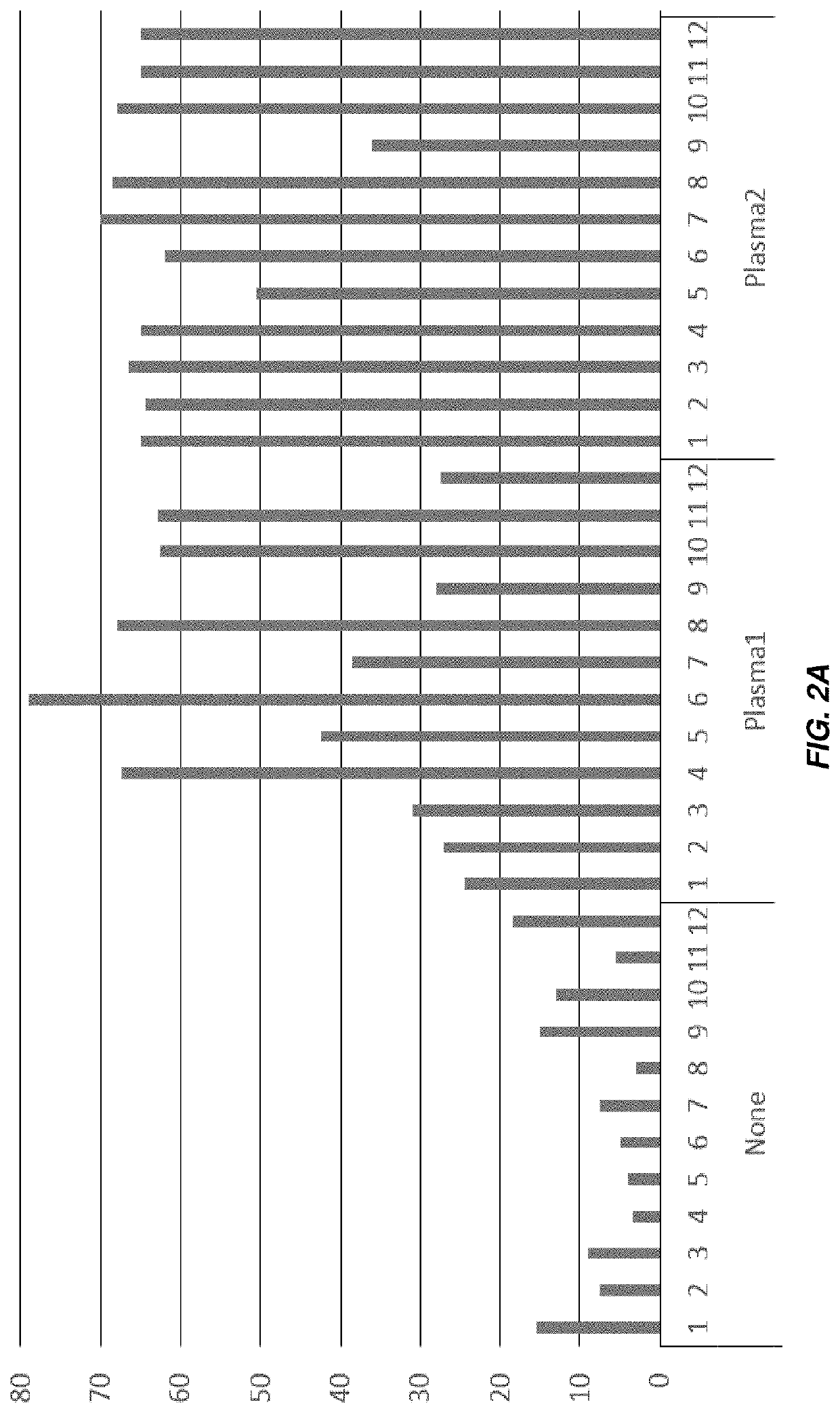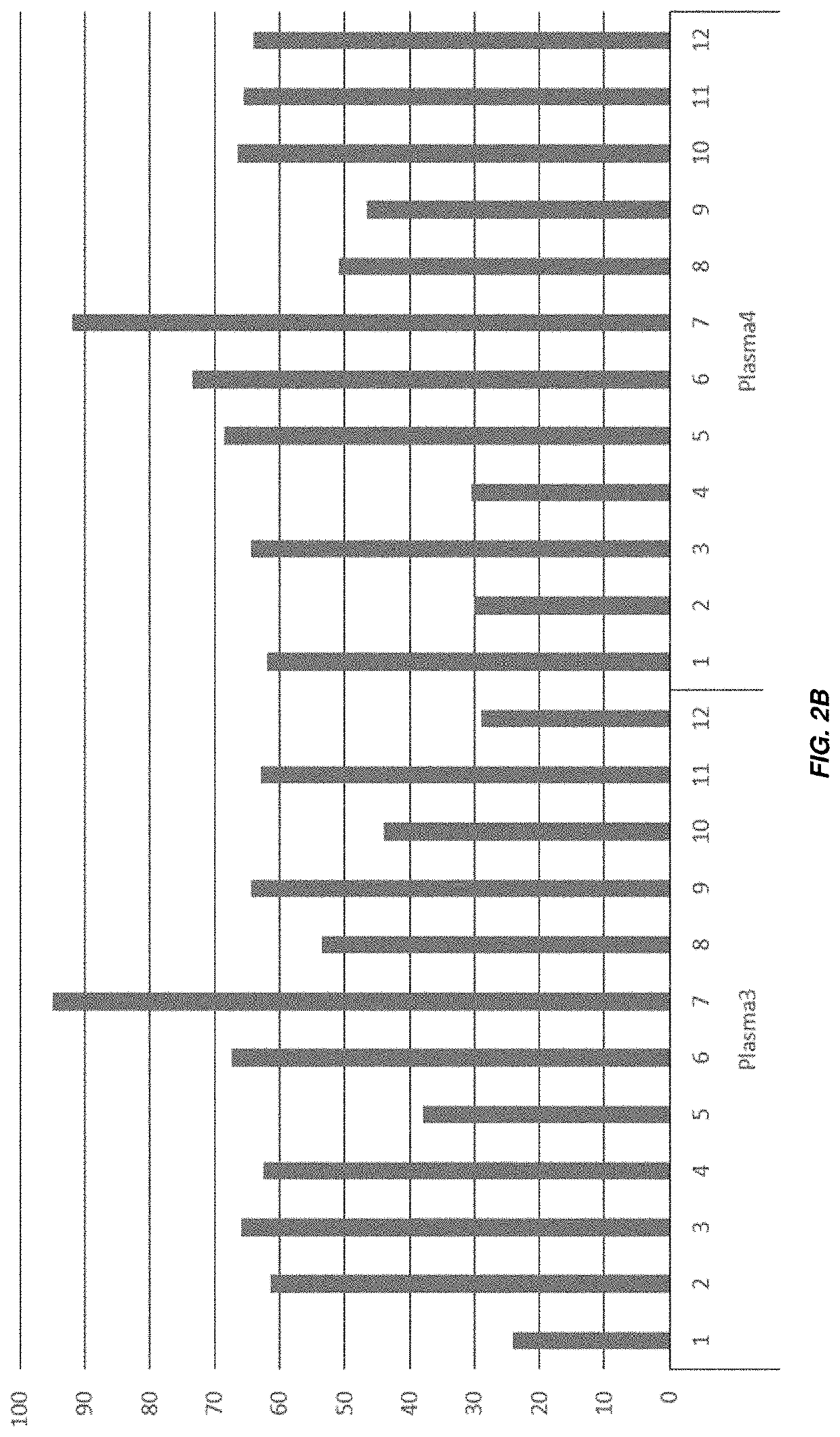Compositions on plasma-treated surfaces
a technology of plasma-treated surfaces and compositions, applied in the field of compositions on plasma-treated surfaces, can solve the problems of insufficient adhesion, compositions may become dislocated or loose, dislocated or loose compositions may complicate or prevent reconstitution, etc., to improve the hydrophilicity of the surface and therefore its wettability, prevent or reduce the frequency of dislocation or loosening of solid compositions, and improve the effect of adhesion
- Summary
- Abstract
- Description
- Claims
- Application Information
AI Technical Summary
Benefits of technology
Problems solved by technology
Method used
Image
Examples
example 1
eatment with Short-Cycle Lyophilization
[0164]FIGS. 2A-2B show bar graphs in which the height of the each bar indicates the number of drops withstood before a pellet became loose in twelve wells each of an untreated cartridge (“None”), or four plasma-treated cartridges (“Plasma1” through “Plasma4”). Lyophilization was performed using a shorter cycle.
[0165]The adhesion of pellets to the wells was noticeably stronger in the plasma-treated wells. In the untreated wells, the pellets became loose following an average of 9.1 drops, while for the Plasma1, Plasma2, Plasma3, and Plasma4 treated wells, the pellets became loose following an average of 46.6, 62.2, 55.7, and 59.4 drops. respectively.
[0166]Additional experiments were performed using cartridges treated with plasma in air and O2. In these experiments, the pellets became loose following an average number of drops between 74 and 88 (data not shown).
example 2
eatment with Long-Cycle Lyophilization
[0167]FIGS. 3A-3B show bar graphs in which the height of the each bar indicates the number of drops withstood before a pellet became loose in twelve wells each of an untreated cartridge (“None”), two cartridges treated with plasma in air (“Plasma / Air 1” and “Plasma / Air 2”), and two cartridges treated with plasma in O2 (“Plasma / O2 1” and “Plasma / O2 2”). Lyophilization was performed using a longer cycle.
[0168]The adhesion of pellets to the wells was noticeably stronger in the plasma-treated wells. In the untreated wells, the pellets became loose following an average of 12.5 drops, while for the Plasma / Air 1, Plasma / Air 2, Plasma / O2 1, Plasma / O2 2 treated wells, the pellets became loose following an average of 36.9, 48.2, 38.8, and 45.0 drops, respectively.
[0169]Cartridges subjected to the Plasma1, Plasma2, Plasma3, and Plasma4 treatments as in Example 1 were filled with trehalose solution and lyophilized using a longer cycle. The pellets became lo...
example 3
eated Cartridge Storage
[0170]Cartridges were subjected to plasma treatment as in Example 1. Following plasma treatment, the cartridges were stored in an oxygen containing environment for a period of time of either 1-day, 30-days, 90-days or 100-days. At the end of the storage period, wells in the cartridge were filled with a saccharide containing PCR reaction solution and the solution was lyophilized. Control cartridges that were not plasma-treated were also filled with the saccharide solution, lyophilized and stored for each of 1-day, 30-days, 90-days, and 100-days.
[0171]Following lyophilization, all of the cartridges containing lyophilized substances were subjected to package performance testing, which is designed to emulate shipping and handling conditions. The individual tests performed were (i) Initial Manual Handling, ASTM D5276-98 Standard, Schedule A, (ii) Stacked Vibration, ASTM D4728-06 Standard, Schedule D, (iii) Loose Load Vibration, ASTM D999-08 Standard, Schedule F, (i...
PUM
 Login to View More
Login to View More Abstract
Description
Claims
Application Information
 Login to View More
Login to View More - R&D
- Intellectual Property
- Life Sciences
- Materials
- Tech Scout
- Unparalleled Data Quality
- Higher Quality Content
- 60% Fewer Hallucinations
Browse by: Latest US Patents, China's latest patents, Technical Efficacy Thesaurus, Application Domain, Technology Topic, Popular Technical Reports.
© 2025 PatSnap. All rights reserved.Legal|Privacy policy|Modern Slavery Act Transparency Statement|Sitemap|About US| Contact US: help@patsnap.com



